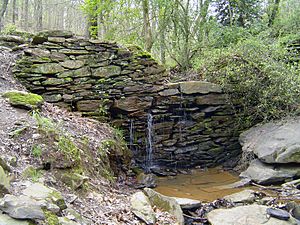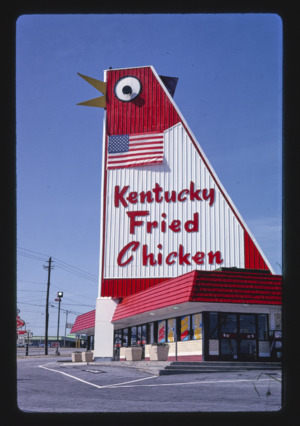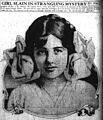Marietta, Georgia facts for kids
Quick facts for kids
Marietta, Georgia
City of Marietta
|
|||
|---|---|---|---|

Fountain in Marietta Square
|
|||
|
|||
| Country | |||
| State | |||
| County | Cobb | ||
| Settled | Before 1824 | ||
| Legally recognized | December 19, 1834 | ||
| Incorporated | 1852 | ||
| Area | |||
| • Total | 23.53 sq mi (60.94 km2) | ||
| • Land | 23.45 sq mi (60.74 km2) | ||
| • Water | 0.08 sq mi (0.20 km2) | ||
| Elevation | 1,129 ft (344 m) | ||
| Population
(2020)
|
|||
| • Total | 60,972 | ||
| • Density | 2,599.86/sq mi (1,003.80/km2) | ||
| 2018 estimate | |||
| Time zone | UTC−5 (EST) | ||
| • Summer (DST) | UTC−4 (EDT) | ||
| ZIP Codes |
30006-08, 30060-69, 30090
|
||
| Area code(s) |
|
||
| FIPS code | 13-49756 | ||
| GNIS feature ID | 0317694 | ||

Marietta is a city in Cobb County, Georgia, United States. It is the main city of Cobb County. In 2020, about 60,972 people lived there. Marietta is one of the biggest suburbs of Atlanta. It is the fourth largest city in the Atlanta metropolitan area.
Contents
History of Marietta
How Marietta Got Its Name
No one is completely sure how Marietta got its name. Many people think it was named after Mary Cobb. She was the wife of U.S. Senator and judge Thomas Willis Cobb. The county itself, Cobb County, is also named after Judge Cobb.
Early Settlers and Growth
People started building homes in the Marietta area before 1824. The city's first map was drawn in 1833. Like many towns, Marietta had a main square with a courthouse. The state of Georgia officially recognized Marietta as a community on December 19, 1834.
The Oakton House was built in 1838. It is the oldest home in Marietta that people have lived in continuously. Its original barn, milk house, and smokehouse are still there. The beautiful gardens have special boxwood plants from the 1870s. During the Battle of Kennesaw Mountain in 1864, Oakton was used as a military headquarters.
Marietta was first chosen as a main stop for the new Western and Atlantic Railroad. This made businesses grow quickly. By 1838, railroad tracks were built north of the city. But in 1840, political problems stopped construction for a while. In 1842, the railroad decided to move its main stop to an area that would become Atlanta. Even so, when the railroad started running in 1850, Marietta still became very successful.
John Glover, a businessman, moved to Marietta in 1848. He was very popular and became mayor when the city officially became a city in 1852. Another early resident was Dr. Carey Cox. He started a "water cure" spa that brought many visitors to the area. He is known as the first doctor in Cobb County.
The Georgia Military Institute was built in 1851. The first bank opened in 1855. During the 1850s, large fires destroyed much of the city three times.
Marietta During the Civil War
By 1861, when the Civil War began, Marietta had recovered from the fires.
In April 1862, a man named James Andrews came to Marietta. He was a civilian working with the Union Army. He came with a small group of Union soldiers dressed in regular clothes. They stayed at the Fletcher House hotel. This hotel is now the Marietta Museum of History. Andrews and his men, called the Andrews Raiders, planned to steal a train. They wanted to go north towards Chattanooga. Their goal was to destroy the railroad tracks along the way. They hoped this would cut off Chattanooga from Atlanta. This would weaken the Confederate forces.
On April 12, 1862, the Raiders got on a train. The train made a stop in a town called Big Shanty (now Kennesaw). When other passengers left for breakfast, Andrews and his men stole the engine and a fuel car. The engine was called The General. This event is known as the Great Locomotive Chase. Andrews and his men did not succeed in their mission. All of them were caught within two weeks. They were put on trial as spies and were hanged.
General William Tecumseh Sherman's army came to Marietta in the summer of 1864. This was part of the Atlanta Campaign. In November 1864, General Hugh Judson Kilpatrick set the town on fire. This was the start of Sherman's March to the Sea. Sherman's troops crossed the Chattahoochee River. They burned the Marietta Paper Mills near Sope Creek before crossing.
The Marietta Confederate Cemetery is in the city. It holds the graves of over 3,000 Confederate soldiers. They died during the Battle of Atlanta.
In 1892, Marietta started a public school system. It had a high school for white students and a separate high school for black students.
Geography and Climate
Where is Marietta Located?
Marietta is in the middle of Cobb County. It is northwest of Smyrna and southeast of Kennesaw. Major roads like U.S. Route 41 and Interstate 75 run through or near the city. Downtown Atlanta is about 20 miles (32 km) to the southeast.
Marietta covers about 23.5 square miles (60.9 square kilometers). Most of this area is land. Only a small part is water.
Marietta's Weather
Marietta has a humid subtropical climate. This means it has hot, humid summers and mild winters. The city is in the USDA 7b Plant Hardiness zone. This zone helps gardeners know which plants can grow there.
| Climate data for Marietta, Georgia | |||||||||||||
|---|---|---|---|---|---|---|---|---|---|---|---|---|---|
| Month | Jan | Feb | Mar | Apr | May | Jun | Jul | Aug | Sep | Oct | Nov | Dec | Year |
| Record high °F (°C) | 80 (27) |
80 (27) |
89 (32) |
93 (34) |
96 (36) |
101 (38) |
104 (40) |
104 (40) |
99 (37) |
92 (33) |
86 (30) |
80 (27) |
104 (40) |
| Mean daily maximum °F (°C) | 52 (11) |
56 (13) |
64 (18) |
73 (23) |
80 (27) |
87 (31) |
89 (32) |
88 (31) |
83 (28) |
73 (23) |
64 (18) |
54 (12) |
72 (22) |
| Mean daily minimum °F (°C) | 30 (−1) |
33 (1) |
39 (4) |
46 (8) |
55 (13) |
64 (18) |
68 (20) |
67 (19) |
60 (16) |
48 (9) |
39 (4) |
32 (0) |
48 (9) |
| Record low °F (°C) | −12 (−24) |
−2 (−19) |
7 (−14) |
21 (−6) |
32 (0) |
40 (4) |
50 (10) |
48 (9) |
30 (−1) |
22 (−6) |
9 (−13) |
−4 (−20) |
−12 (−24) |
| Average precipitation inches (mm) | 4.86 (123) |
5.36 (136) |
5.07 (129) |
3.93 (100) |
4.12 (105) |
4.07 (103) |
5.10 (130) |
4.35 (110) |
4.10 (104) |
3.42 (87) |
4.30 (109) |
4.49 (114) |
54.63 (1,388) |
People in Marietta
Population Changes Over Time
| Historical population | |||
|---|---|---|---|
| Census | Pop. | %± | |
| 1870 | 1,888 | — | |
| 1880 | 2,227 | 18.0% | |
| 1890 | 3,384 | 52.0% | |
| 1900 | 4,446 | 31.4% | |
| 1910 | 5,949 | 33.8% | |
| 1920 | 6,190 | 4.1% | |
| 1930 | 7,638 | 23.4% | |
| 1940 | 8,667 | 13.5% | |
| 1950 | 20,687 | 138.7% | |
| 1960 | 25,565 | 23.6% | |
| 1970 | 27,216 | 6.5% | |
| 1980 | 30,805 | 13.2% | |
| 1990 | 44,129 | 43.3% | |
| 2000 | 58,748 | 33.1% | |
| 2010 | 56,579 | −3.7% | |
| 2020 | 60,972 | 7.8% | |
| U.S. Decennial Census 1850-1870 1870-1880 1890-1910 1920-1930 1940 1950 1960 1970 1980 1990 2000 2010 |
|||
Marietta's Population in 2020
| Race | Num. | Perc. |
|---|---|---|
| White (non-Hispanic) | 25,610 | 42.0% |
| Black or African American (non-Hispanic) | 17,564 | 28.81% |
| Native American | 135 | 0.22% |
| Asian | 1,765 | 2.89% |
| Pacific Islander | 35 | 0.06% |
| Other/Mixed | 3,335 | 5.47% |
| Hispanic or Latino | 12,528 | 20.55% |
In 2020, the city had 60,972 people living in it. There were 24,554 households and 13,788 families.
Marietta's Population in 2010
In 2010, there were 56,641 people and 22,261 households. The population density was about 2,684 people per square mile. There were 25,227 housing units.
About 27.8% of households had children under 18. About 35.4% were married couples living together. About 13.8% had a female head of household with no husband. Also, 45.5% were not families.
About 22.4% of the people were under 18. About 14.1% were 18 to 24 years old. About 39.4% were 25 to 44 years old. The average age was 30 years. For every 100 females, there were about 101 males.
Economy and Jobs
Income in Marietta
In 2022, the average income for a household was $67,589. The income per person was $40,767. About 12.8% of the people lived below the poverty line.
Major Industries and Employers
Dobbins Air Reserve Base and a Lockheed Martin factory are big employers in Marietta. Lockheed Martin makes airplanes and other things. The Lockheed Georgia Employees Credit Union is also based here.
Here are the top employers in Marietta as of 2021:
| # | Employer | Employees |
|---|---|---|
| 1 | WellStar Kennestone Hospital | 5,055 |
| 2 | Dobbins Air Reserve Base | 2,000 |
| 3 | Cobb County Public Safety | 1,600 |
| 4 | Tip Top Poultry | 1,400 |
| 5 | Cobb County Board of Education | 1,368 |
| 6 | Marietta City Schools | 1,266 |
| 7 | Cobb County Government | 1,171 |
| 8 | XPO, Inc. Last Mile | 750 |
| 9 | City of Marietta | 716 |
| 10 | Cobb Energy Membership Corp (EMC) | 640 |
City Services and Transportation
Utilities and Roads
The city of Marietta runs its own power company, Marietta Power. It is managed by the Board of Lights & Water.
Major roads like Interstate 75 and U.S. 41 go through the eastern part of the city. Other state roads also pass through Marietta.
Public Transportation
CobbLinc is Marietta and Cobb County's public transportation system. Xpress GA Buses also serve the city.
Train Services
CSX freight trains still run near the town square. They follow the old Western and Atlantic Railroad route. The old railroad depot from 1898 is now the Visitor Center.
Passenger trains used to stop in Marietta. Until the 1950s, the Louisville and Nashville Railroad ran trains like the Flamingo and Southland through Marietta. The last passenger train, the Georgian, stopped service in 1971.
Media and Sports
Local News
The Marietta Daily Journal is the local newspaper published in the city.
Sports Achievements
The East Marietta National Little League team won the 1983 Little League World Series. They beat a team from the Dominican Republic to become world champions.
Education in Marietta
All public schools within Marietta city limits are run by Marietta City Schools (MCS). Schools outside the city limits in Cobb County are run by the Cobb County School District.
MCS has one high school, Marietta High School (grades 9-12). It also has a middle school, Marietta Middle School (grades 7-8), and Marietta Sixth Grade Academy. There are several elementary schools too: A.L. Burruss, Dunleith, Hickory Hills, Lockheed, Marietta Center for Advanced Academics, Park Street, Sawyer Road, and West Side.
Many Marietta residents attend Cobb County public schools. These include Joseph Wheeler High School, Sprayberry High School, Alan C. Pope High School, and Walton High School. These schools often have strong sports rivalries, especially in basketball.
The Walker School is a private school in Marietta. It teaches students from pre-kindergarten through 12th grade.
Marietta City Schools employs 1,200 people. MCS is an International Baccalaureate (IB) World School district. This means it offers special programs for students. In 2008, MCS became one of the first districts in Georgia to offer the IB Middle Years Program (MYP) for grades 6-10. MCS is one of the few school systems in the country that offers the full IB program (Kindergarten through 12th grade).
The Marietta Campus of Kennesaw State University is located here. It used to be Southern Polytechnic State University. Life University is also in Marietta. These universities serve over 20,000 students. They offer more than 90 different study programs.
Culture and Landmarks

Marietta has six historic districts. Some of these are listed on the National Register of Historic Places. These include Northwest Marietta, Whitlock Avenue, Washington Avenue, and Church-Cherokee Streets. The city's visitor center is in the old train depot.
The town square is in downtown Marietta. It used to be where the county courthouse was. The square hosts many cultural events and public gatherings. This includes a weekly farmers' market.
The Marietta Players put on semi-professional theater shows all year. The historic Strand Theatre has been restored. It now hosts live theater, concerts, classic films, and other events. The Marietta/Cobb Museum of Art is in the old Post Office building.
The Marietta History Center shows the history of the city and county. It has many items from Marietta residents and businesses. The Marietta Gone with the Wind Museum has a private collection of items related to the famous book and film Gone with the Wind. The William Root House Museum and Garden is the oldest wooden house still standing in Marietta. It was built around 1845. William Root was an early citizen and merchant in Marietta.
The Big Chicken is a very famous landmark. It sits on top of a KFC restaurant. It has been a well-known sight since 1963.
Some movies have filmed scenes in Marietta. The 1995 movie Gordy and the 2014 film Dumb and Dumber To both filmed here.
The Kennesaw House is one of only four commercial buildings in Marietta that General Sherman's army did not burn during the Civil War. Today, the Kennesaw House is home to the Marietta History Center.
Notable People from Marietta
- Shareef Abdur-Rahim, former professional basketball player
- Murray Attaway, singer/songwriter
- Alton Brown, host of Good Eats
- Marcus Alexander Bagwell, professional wrestler
- Alan Ball, Academy Award-winning screenwriter
- Chris Beard, basketball coach
- Alice Birney (1858–1907), co-founder of National Parent-Teacher Association
- Rodrigo Blankenship, American football placekicker
- Billy Burns, Major League Baseball player
- Jaylen Brown, NBA player
- Marlon Byrd, former Major League Baseball player
- K Camp, rapper
- James M. Canty, educator and businessman
- Lucius D. Clay, US Army general
- Jason Damm, rugby union player
- Jonathan Dwyer, former NFL player
- Ajani Fortune, soccer player
- Frank Freyer, 14th Naval Governor of Guam
- George H. Gay Jr., sole survivor of Torpedo Squadron 8 at Battle of Midway
- Arik Gilbert, football player
- Yaya Han, Chinese-American cosplayer
- Corey Heim, NASCAR driver
- Cedric Henderson, NBA player
- Scoot Henderson, NBA player
- Jack Hensley, American who died in Iraq
- Richard Howell (born 1990), American-Israeli basketball player
- Marvin Hudson, Major League Baseball umpire
- Lucy McBath, activist and US Representative
- Jerick McKinnon, NFL Player
- Adam Morgan, MLB player
- Jim Nash, former MLB player
- Melanie Oudin, professional tennis player
- Jennifer Paige, singer
- Lennon Parham, actress and comedian
- Robert Patrick, actor
- Ron Pope, singer/songwriter
- Marco Restrepo, musician
- Billy Joe Royal, singer
- Chris Robinson, former Black Crowes singer
- Rich Robinson, former Black Crowes guitar player
- Cody Rhodes (Cody Runnels), professional wrestler
- Ray Traylor, professional wrestler known as Big Boss Man
- Lawson Vaughn, MLS professional soccer player
- Trey Sermon, American football running back
- Daniela Silivaș-Harper, Romanian gymnast and coach
- Ron Simmons, professional wrestler
- Dansby Swanson, Major League Baseball player
- Emily Sonnett, professional soccer player for the U.S. women's national soccer team
- Luke Thomas, MMA journalist
- Travis Tritt, country music singer and composer
- Jeff Walls, guitarist, songwriter
- Isadora Williams, American-Brazilian figure skater
- Michael Len Williams II (Mike Will Made It), record producer
- Trey Wolfe, professional football player
- Xavier Woods (Austin Watson), professional wrestler
- Joanne Woodward, actress
- Jabari Zuniga, NFL player
- Isaiah Collier, NBA player
Sister Cities
Marietta has two sister cities. These are cities that share a special bond to promote cultural ties.
 Heredia, Costa Rica
Heredia, Costa Rica Linz am Rhein, Rhineland-Palatinate, Germany
Linz am Rhein, Rhineland-Palatinate, Germany
Images for kids
See also
 In Spanish: Marietta (Georgia) para niños
In Spanish: Marietta (Georgia) para niños




